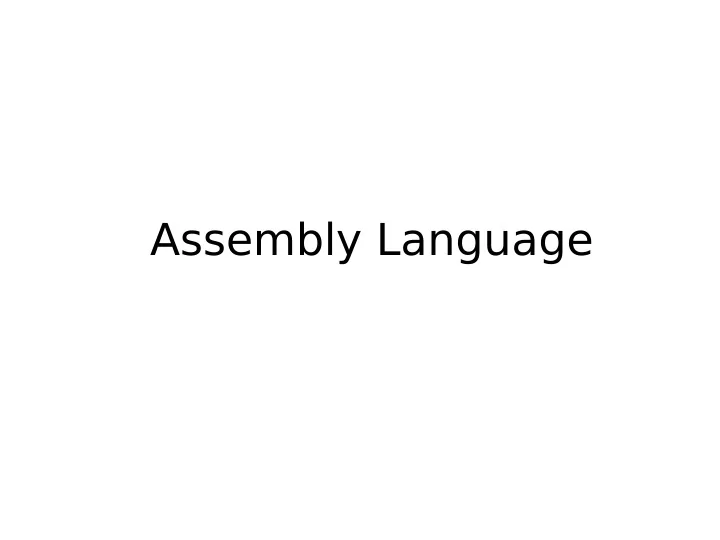

Assembly Language
Assembly Language: Human Readable Machine Language Computers like ones and zeroes… 0001110010000110 Humans like symbols… R0,R17 ; increment index reg. ADD An assembler is a program that translates symbols for instructions into actual machine instructions. • ISA-specific • Close relationship between symbols and insn-set • Mnemonics for opcodes • Labels for memory locations • Additional operations (directives) for various tasks like allocating and initializing storage
Example Assembly Language Program ;This program multiplies the value in r17 (23) by the value in r16 (6) ; and places the result in r0. It will work on the atmega328P . jmp entry .org 0x100 entry: ldi r16, 6 ldi r17, 23 ldi r18, -1 eor r0, r0 loop: add r0, r17 add r16, r18 brbc 1, loop sink: rjmp sink
AVR Assembly Language Syntax • Each line of a program is one of the following: – an instruction – an assember directive (or pseudo-op) – a comment • Whitespace (between symbols) and case are ignored. • Comments (beginning with “;”) are also ignored. • An instruction has the following format: LABEL OPCODE OPERANDS ; COMMENTS optional mandatory
Opcodes and Operands • Opcodes – reserved symbols that correspond to AVR instructions • ex: add , eor , ldi , brbc , … • Operands – registers -- specifjed by Rn, where n is the register number – numbers – Hexadecimal indicated by 0x or $ – label -- symbolic name of memory location – Operands separated by commas – number, order, and type correspond to instruction format • ex: add r1,r3 com r1 ldi r31,0xff brbc 1,loop
Labels and Comments • Label – placed at the beginning of the line – assigns a symbolic name to the address corresponding to line • ex: loop: add r1,r3 brvc loop • Comment – anything after a semicolon is a comment – ignored by assembler – used by humans to document/understand programs – tips for useful comments: • Do what you feel is useful
Assembler Directives • Pseudo-operations – do not refer to operations executed by program – used by the assembler – look like instructions, but the “opcode” starts with dot – assembler-specifjc Opcode Operand Meaning .ORG address starting addr of next insn in PMEM .BYTE expressions Place bytes from exprs in code .SET symbol,expr Set value of symbol to expression Repeat,size, allocate one word, initialize with .FILL value value n .SECTION sectionname Place following code into section sectionname
Assembly Process • Convert assembly language fjle (.asm) into an executable fjle (.hex) for the AVR. • First Pass: – scan program fjle – fjnd all labels and calculate the corresponding addresses; this is called the symbol table • Second Pass: – convert instructions to machine language, using information from symbol table
First Pass: Constructing the Symbol T able 1. Initialize the location counter (LC) which keeps track of the address of the current instruction. – On AVR, LC is initialized to 0. 2. For each non-empty line in the program: a) If line contains a label, add label and LC to symbol table. b) Increment LC. – NOTE: If statement is .BYTE or .FILL , increment LC by the number of words allocated. 3. Stop when tend of fjle is reached. • NOTE: A line that contains only a comment is considered an empty line.
Second Pass: Generating Machine Language • For each executable assembly language statement, generate the corresponding machine language instruction. – If operand is a label, look up the address from the symbol table. • Potential problems: – Improper number or type of arguments • ex: rcallr3 ldi r0,0xff add r3,r3,128 – Immediate argument too large • ex: ori r1,0xdeadbeef
Linking and Loading • Loading is the process of copying an executable image into memory. – more sophisticated loaders are able to relocate images to fjt into available memory – must readjust branch targets, load/store addresses • Linking is the process of resolving symbols between independent object fjles. – suppose we defjne a symbol in one module, and want to use it in another – some notation, such as .extern , is used to tell the assembler that a symbol is defjned in another module – linker will search symbol tables of other modules to resolve symbols and complete code generation before loading
Building An Assembly Language Program Using GNU T oolchain • avr-as –mmcu=atmega328p myfjle.asm – produces a.out • avr-ld –m avr5 –o myfjle.elf a.out – produces .elf fjle from a.out • avr-objcopy –O ihex –R .eeprom myfjle.elf myfjle.hex – produces Intel .hex (ROM image) from .elf • ldino –P myfjle.hex – Programs the atmega328p on Arduino with contents of myfjle.hex
Recommend
More recommend